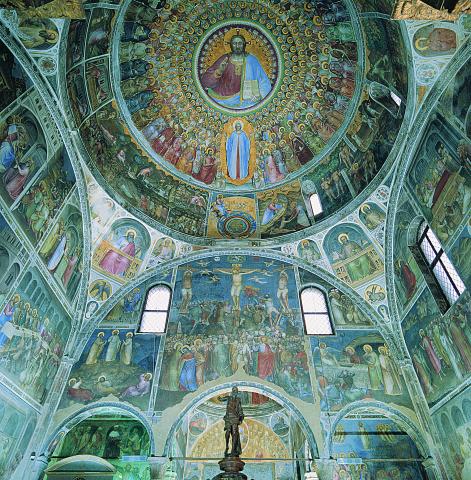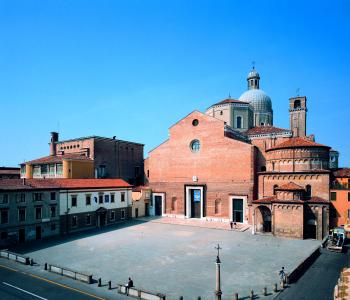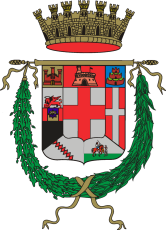
Tipologia museo

Descrizione
Il Duomo sorge sul luogo di precedenti edifici sacri di cui il più antico, una cattedrale paleocristiana, sorgeva probabilmente sull'attuale sagrato La nuova cattedrale consacrata nel 1075 dal Vescovo Ulderico fu danneggiata pochi anni dopo nel terremoto del 1117 La realizzazione dell'attuale Duomo fu compiuta tra il XVI ed il XVIII secolo. Vincitore del concorso che era stato bandito risultò Michelangelo ma l'esecuzione dei lavori fu affidata all'architetto istriano Andrea da Valle e all'architetto Agostino Righetti che apportarono sostanziali modifiche al progetto originario. Il Duomo fu completato solo nel 1754 dall'architetto veneziano Girolamo Frigimelica anche se la grandiosa facciata con tre portali e due rosoni, da lui disegnata, non fu mai terminata e in seguito gravemente danneggiata, assieme alla grande cupola, nei bombardamenti del 1917 e 1918. Nel XIV secolo, nella sacrestia, sostenevano gli esami i laureandi in Legge, in chiesa invece gli studenti delle altre facoltà, mentre "il baccellierato" (grado che veniva conferito nel Medioevo allo studente che aveva conseguito il primo grado accademico, inferiore a quello di dottore), la "licenza" e la "laurea" venivano conferiti dal Vescovo nel salone che è in piazza, che porta ancor oggi scolpite, sul frontone della porta, tre teste di bue, il famoso stemma dell'Università. Nell'antistante piazza si teneva il "mercato dei porci", ma poi quando la piazza fu donata alla chiesa, essa fu adibita a cimitero divenendo quindi prato e in seguito, nel 1904, venne lastricata. L'armonioso e luminoso interno, che ricorda quello di S. Giustina, è a croce latina con tre navate suddivise da pilastri. Sulla sinistra, nella Cappella della Madonna dei ciechi, è conservata una Madonna col bambino di Stefano dall'Arzere. Di Pietro Damini possiamo ammirare al secondo altare San Girolamo e il committente Girolamo Selvatico e nella terza cappella, la pala raffigurante Gesù Crocifisso con le sante Maddalena e Caterina. Presso la porta laterale il cenotafio (monumento sepolcrale onorario che non contiene la spoglia del defunto) di Francesco Petrarca che fu canonico del Duomo, opera ottocentesca di Rinaldo Rinaldi. La sacrestia dei Canonici conserva preziose opere d'arte tra cui una Madonna col bambino di Giusto de' Menabuoi, due pannelli con Santi di Giorgio Schiavone e due tele di Giandomenico Tiepolo raffiguranti San Filippo Neri e San Girolamo Emiliani e una pregevole Deposizione di Jacopo Montagnana. Nell'armadio intagliato in noce del 1563 sono conservati preziosi reliquiari del XV secolo tra cui una croce processionale in argento dorato del 1228, un calamaio d'argento, una croce e due candelieri in argento e cristallo di rocca del XVI secolo. Il presbiterio, inaugurato nel 1997 dopo alcuni lavori di restauro, è adornato con le statue dello scultore toscano Giuliano Vangi. Scesi nella cripta possiamo ammirare l'altare di San Daniele con bassorilievi di Tiziano Aspetti 1565-1607 Nel transetto di destra, in fondo, sull'altare, l'icona raffigurante la Madonna col bambino che un'antica tradizione vuole sia appartenuta al Petrarca il quale credeva che fosse stata dipinta da Giotto. Il sottosuolo della Cattedrale conserva mosaici, resti di colonne, urne di terracotta, pietra lavorate, ossa di bue e di cavallo, forse resti di antichi sacrifici pagani. Alcuni capitelli bizantini con l'iscrizione alla Dea Fortuna si trovano ora al Museo Civico agli Eremitani, altri oggetti, quali pietre, croci ecc., sono nel Museo Diocesano. Collegato al Duomo è il Battistero romanico intitolato a San Giovanni Battista. L'edificio risale alla fine del XII secolo ma è stato ricostruito nella sua forma attuale nel 1260 e consacrato nel 1281; ha pianta quadrata con alto tamburo circolare e cupola e un'abside. Il ciclo di affreschi eseguiti tra il 1375-78voluti da Francesco da Carrara è uno dei cicli pittorici meglio conservati del trecento.
 Duomo Baptistery
Duomo Baptistery
The Duomo stands on the site of previous sacred buildings, among which the most ancient, a Paleochristian cathedral, probably stood on the current parvis. The new cathedral, consecrated in 1075 by bishop Ulderico, was damaged a few years later during the earthquake of 1117. The present cathedral was built between the XVI and XVII centuries. Michelangelo was the winner of the contest that had been called for its construction. Still, the Istrian architect Andrea da Valle and Agostino Righetti directed the execution of the work and made substantial changes to the original project. The Venetian architect Girolamo Frigimelica completed the Duomo only in 1754, even though the majestic facade with three portals and two rose windows he designed has never been finished. It was damaged together with the significant dome in the bombings of 1917 and 1918. In the XIV century, law students about to graduate used the sacristy to take exams, while students from other departments had their ceremony inside the church. The bishop conferred the "baccelierato" (a degree that was given in the Middle Ages to the student who had earned the first academic degree but was lower than the bachelor's degree), the "license", and the "degree" in the hall that there is in the square. The room still carries three ox heads (the famous coat of arms of the University) carved on the door pediment. In the square in front of the church, there was the "Porks market". Later, when the owners gave it to the church, the square was used as a cemetery, thus becoming a lawn, and then, in 1904, it was paved. The harmonious and bright inside, which reminds the one in St. Giustina, is a Latin cross with three naves divided by pillars. On the left, in the Chapel of the Madonna of the Blind, visitors may see an accurately preserved Madonna with Child by Stefano dall'Arzere. They may also admire Pietro Damini's St. Girolamo and the buyer Girolamo Selvatico on the second altar and, in the third chapel, the altarpiece portraying Jesus crucified with St. Maddalena and St. Caterina. Near the side door, there is a nineteenth-century piece of art by Rinaldo Rinaldi: the cenotaph (honorary sepulchral monument that does not contain the remains of the dead) of Francesco Petrarca, canon of the Duomo. The sacristy of the Canons preserves precious pieces of art, including a Madonna and Child by Giusto de' Menabuoi, two panels with Saints by Giorgio Schiavone, and two paintings by Giandomenico Tiepolo portraying St. Filippo Neri and St. Girolamo Emiliani. It also includes an exquisite Deposition by Jacopo Montagnana. In the cabinet carved in walnut that comes directly from 1563 are preserved precious relics of the fifteenth century, including a processional cross in gilded silver that dates back to 1228, a silver inkwell, a cross, and two candlesticks in silver and rock crystal of the sixteenth century. The presbytery, inaugurated in 1997 after the restoration, has been adorned with the statues of the Tuscan sculptor Giuliano Vangi. Visitors may admire the altar of St. Daniele in the crypt with bas-reliefs by Tiziano Aspetti (1565-1607). At the bottom of the right transept, there is an icon representing the Madonna and Child on the altar. An ancient tradition says it belonged to Petrarca, who believed Giotto painted it. The subsoil of the cathedral holds mosaics, remains of columns, terracotta urns, worked stones, and ox and horse bones that possibly are remains of ancient pagan sacrifices. There are some Byzantine capitals at the Civic Museums of the Eremitani, and visitors may find more items at the Diocesan Museum. The Roman Baptistery entitled to St. Giovanni Battista is connected to the Duomo. It dates back to the end of the XII century but was rebuilt in 1260 and then consecrated in 1281. It has a square layout with a high circular tambour, dome, and an apse. The cycle of frescoes executed between 1375-78 by Francesco da Carrara is one of the best-preserved pictorial cycles of the fourteenth century.

